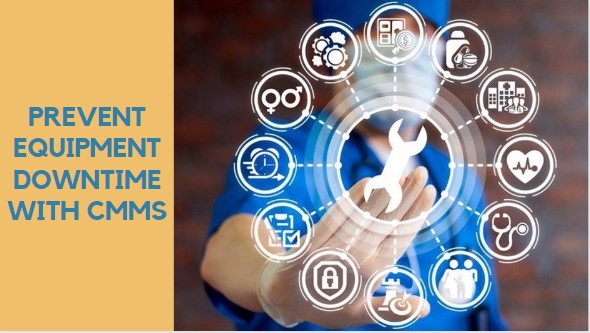
7 ways to reduce downtime using CMMS software
Madhurima Sanyal |
08 Jun 2024 |
12:06 PM
- Understanding Asset Downtime
- Importance of Efficient Asset Management
- Minimizing Equipment Downtime
- How Digitization Addresses Common Causes
- Role of CMMS Software in Reducing Downtime
- How Software Solutions Help Eliminate Downtime and Cut Maintenance Costs
- Differentiating Planned vs. Unplanned Downtime
- CMMS Best Practices
- Conclusion

How Plant Maintenance Software Transforms Industrial Operations
Madhurima Sanyal 09 Jun 2024 | 07:17 AMExplore the potential of Plant Maintenance Software, and how it is revolutionizing your industrial facility's efficiency. Discover predictive maintenance, asset tracking, and real-time reporting for a seamless, high-quality operation. ...
Asset downtime can significantly impact business operations, leading to decreased productivity and increased maintenance software costs. Understanding the nuances of asset downtime is crucial in implementing effective strategies to mitigate its impact. Let's understand the fundamentals.
Understanding Asset Downtime
Asset downtime refers to the period when machinery, equipment, or critical assets are non-operational, resulting in halted production or decreased efficiency. This downtime could arise due to various reasons such as equipment failure, lack of maintenance, or unforeseen breakdowns. It's vital to comprehend the ramifications of downtime across industries to address its root causes effectively.
Importance of Efficient Asset Management
Efficient asset management plays a pivotal role in reducing downtime. By employing proactive measures and leveraging technological advancements like CMMS (Computerized Maintenance Management Systems) software, companies can optimize asset performance. A robust asset management strategy not only minimizes downtime but also enhances operational efficiency and extends the lifespan of equipment.
Incorporating maintenance software facilitates streamlined processes, allowing for predictive maintenance, scheduling, and tracking of tasks. This technology empowers maintenance teams by providing real-time data insights, enabling timely interventions and preventive measures to avert downtime.
Reducing asset downtime is more than a cost-saving initiative; it's a strategic move toward ensuring consistent productivity and operational continuity. The integration of CMMS software stands as a linchpin in achieving this objective, transforming reactive maintenance into a proactive and data-driven approach.
By understanding the gravity of asset downtime and embracing advanced solutions like CMMS software, companies can revolutionize their maintenance practices and pave the way for uninterrupted operations.
Minimizing Equipment Downtime
Equipment downtime poses a significant challenge across industries, impacting productivity and operational efficiency. Leveraging effective strategies and digitization through CMMS software can remarkably mitigate this issue.
Exploring Seven Effective Strategies to minimize downtime
-
Proactive Maintenance Schedules: Implementing proactive maintenance schedules ensures timely inspections and servicing, preventing unexpected breakdowns.
-
Data-Driven Predictive Maintenance: Utilizing historical data and predictive analytics allows for proactive identification of potential equipment failures, enabling preemptive action.
-
Utilization of CMMS Software: Integrating CMMS software streamlines maintenance tasks, schedules, and tracks equipment performance, enhancing maintenance efficiency.
-
Regular Equipment Inspections: Conducting routine inspections helps identify and rectify minor issues before they escalate, ensuring uninterrupted operations.
-
Training Maintenance Teams: Empowering maintenance team with specialized training equips them to handle and prevent downtime effectively.
-
Optimizing Spare Parts Management: Maintaining adequate spare parts inventory reduce downtime during repairs or replacements.
-
Implementing Contingency Plans: Developing contingency plans prepares businesses to respond swiftly to unexpected downtime scenarios, minimizing its impact.
How Digitization Addresses Common Causes
Digitization, particularly through CMMS software, addresses common causes of asset downtime comprehensively. By harnessing real-time data insights, this technology predicts potential failures, allowing for preemptive maintenance. It facilitates the creation of proactive maintenance schedules, ensures proper resource allocation, and streamlines communication among maintenance team.
Moreover, digitization helps in standardizing maintenance processes, ensuring adherence to best practices, and optimizing workflows. Through this digitized approach, businesses reduce downtime, prevents breakdowns and improves operational efficiency.
Preventive Maintenance Planning
Conducting a Risk Audit
Begin by conducting a comprehensive risk audit to identify potential areas of vulnerability within your equipment and operational processes. Analyze historical data, equipment failure patterns, and industry benchmarks to pinpoint high-risk components or systems. This audit enables a proactive approach to address foreseeable issues before they escalate into downtime-inducing problems.
Leveraging Data for Informed Decision-Making
Leveraging data is pivotal in making informed decisions regarding preventive maintenance. CMMS software facilitates the collection and analysis of real-time data, providing insights into equipment performance, maintenance history, and trends. By harnessing this data, businesses can create predictive maintenance models, anticipate potential failures, and schedule maintenance activities proactively, thereby mitigating unplanned downtime.
Setting Up Preventive Maintenance Plans
Establishing robust preventive maintenance plans involves a strategic approach. Utilize the insights gained from risk audits and data analysis to design tailored maintenance schedules. Incorporate predictive maintenance techniques, routine inspections, and scheduled maintenance into the plans.
CMMS software plays a vital role in this phase by enabling the creation and implementation of detailed preventive maintenance schedules, ensuring that equipment remains in optimal condition.
Partner with Proptor App to optimize efficiency. The Proptor App revolutionizes preventive maintenance by providing property owners with a comprehensive suite of tools for streamlined upkeep. Its features encompass maintenance scheduling, task reminders, and documentation capabilities, ensuring timely and meticulous maintenance planning. With inventory management and customizable checklists tailored to specific property needs, Proptor optimizes preventive maintenance efforts.
The app's reporting and analytics empower informed decision-making by tracking tasks, expenses, and property performance. Facilitating seamless communication among stakeholders and storing historical data for trend analysis, Proptor fosters efficient collaboration and data-driven planning.
Preventive maintenance plans should be dynamic, allowing for adjustments based on real-time data, evolving equipment needs, and changing operational demands. Regularly review and refine these plans to optimize efficiency and minimize downtime effectively.
By adopting a proactive approach to maintenance planning and leveraging the capabilities of CMMS software, businesses can significantly reduce asset downtime, enhance equipment reliability, and maximize operational productivity.
Role of CMMS Software in Reducing Downtime
Central to achieving the goal of minimizing asset downtime, is the effective utilization of Computerized Maintenance Management System (CMMS) software. This section will delve into the pivotal role played by CMMS software in curtailing downtime, exploring its functionalities and cost-saving benefits.
CMMS (Computerized Maintenance Management System) software is a powerful tool designed to streamline and optimize maintenance processes within an organization. It acts as a centralized hub for managing maintenance activities, providing a comprehensive platform to schedule, track, and analyze maintenance tasks efficiently.
This software incorporates various functionalities, including asset management, work order management, preventive maintenance scheduling, inventory management, and reporting capabilities. By centralizing these operations, CMMS software empowers maintenance teams to proactively manage equipment and facilities, minimizing downtime and maximizing productivity.
Understanding CMMS Software
CMMS (Computerized Maintenance Management System) software is a powerful tool designed to streamline and optimize maintenance processes within an organization. It acts as a centralized hub for managing maintenance activities, providing a comprehensive platform to schedule, track, and analyze maintenance tasks efficiently.
This software incorporates various functionalities, including asset management, work order management, preventive maintenance scheduling, inventory management, and reporting capabilities. By centralizing these operations, CMMS software empowers maintenance teams to proactively manage equipment and facilities, minimizing downtime and maximizing productivity.
How Software Solutions Help Eliminate Downtime and Cut Maintenance Costs
CMMS software plays a pivotal role in eliminating downtime and curbing maintenance costs through several key functionalities:
-
Predictive Maintenance: Leveraging historical data and real-time insights, CMMS software enables predictive maintenance. By analyzing equipment performance metrics and trends, it forecasts potential failures, allowing preemptive maintenance actions to prevent downtime.
-
Efficient Resource Allocation: With CMMS software, maintenance teams can optimize resource allocation. They can effectively schedule maintenance work orders, allocate manpower, and manage inventory, ensuring that the right resources are available at the right time, minimizing downtime due to resource shortages.
-
Streamlined Maintenance Processes: The software streamlines maintenance processes by automating workflows, providing step-by-step guidance, and ensuring adherence to standardized procedures. This automation enhances efficiency, reduces human error, and accelerates the resolution of maintenance issues, thereby reducing downtime.
-
Real-time Monitoring and Reporting: CMMS software offers real-time monitoring capabilities, allowing for instant detection of equipment anomalies or potential failures. It generates comprehensive reports on equipment performance, maintenance history, and costs, enabling data-driven decision-making for optimizing maintenance strategies.
By embracing CMMS software, businesses can revolutionize their maintenance operations, proactively prevent downtime, optimize asset performance, and ultimately reduce maintenance costs significantly.
Differentiating Planned vs. Unplanned Downtime
Understanding the distinction between planned downtime and unplanned downtime is crucial in developing effective strategies to minimize disruptions in asset performance and productivity.
Prioritizing Proactive Maintenance
Planned downtime refers to scheduled interruptions in operations for maintenance, upgrades, or inspections. Prioritizing proactive maintenance involves strategically scheduling these downtime periods when equipment or systems are offline. By utilizing CMMS software, organizations can optimize these schedules, ensuring minimal impact on overall productivity while conducting necessary maintenance activities.
Analyzing Unplanned Downtime Events
Unplanned downtime, on the other hand, occurs unexpectedly due to unforeseen equipment failures, malfunctions, or environmental incidents. Analyzing these events involves delving into root causes, identifying patterns, and leveraging historical data stored in CMMS software. Such analysis helps in devising preventive strategies, mitigating potential risks, and minimizing the occurrence and impact of unexpected downtime events.
Exploring the Costs of Unplanned Downtime
Unplanned downtime poses significant financial implications for businesses. It disrupts production schedules, affects product quality, and leads to revenue loss. Utilizing CMMS software to assess the costs associated with such downtime events provides a clear understanding of the financial impact. This analysis empowers decision-makers to allocate resources effectively towards preventive measures, thus reducing the overall costs incurred due to unplanned downtime.
Understanding the differences between planned and unplanned downtime and harnessing the capabilities of CMMS software aids businesses in strategizing to minimize interruptions, optimize maintenance schedules, and ultimately enhance operational efficiency.
Effective Maintenance Strategies
Implementing effective maintenance strategies is key to reducing asset downtime and ensuring optimal operational performance.
Conducting Daily Inspections - Routine daily inspections are fundamental in identifying potential issues before they escalate into major problems.
Tracking Equipment Life Spans - Tracking the life span of equipment aids in predictive maintenance planning. CMMS software facilitates real-time monitoring of equipment usage, performance trends, and maintenance histories.
Implementing Maintenance Checklists - Maintenance checklists serve as structured guides for maintenance technicians during inspections and maintenance tasks. Standardized checklists improve accuracy, consistency, and adherence to maintenance protocols, minimize errors and reduce downtime.
Importance of Employee Communications and Training - Clear communication channels foster collaboration, ensuring everyone is aligned on maintenance priorities and procedures.
CMMS Best Practices
Embracing User Training and Support
Providing thorough instructions and ongoing support ensures that all staff members are adept at navigating and utilizing the software's functionalities. This empowers your team to efficiently manage maintenance tasks, streamline workflows, and promptly address issues, significantly reducing asset downtime.
Customizing Preventive Maintenance Plans
Leveraging CMMS software, create and implement customized schedules for routine maintenance tasks, inspections, and equipment servicing. This enables you to detect potential issues and resolve proactively, also significantly reduce downtime.
Regular Software Updates and Maintenance
Software updates often include bug fixes, security enhancements, and improved functionalities that optimize system performance. Moreover, routine maintenance of the software itself ensures smooth operation, reducing the risk of software-related disruptions that could lead to downtime.
Conclusion
In a competitive landscape where operational efficiency is pivotal, reduce downtime since it stands as a strategic imperative. Leveraging CMMS software alongside proactive maintenance practices emerges as the most realistic choice in ensuring uninterrupted operations.
By embracing user training, customizing preventive maintenance plans, and harnessing real-time insights, organizations pave the way for seamless workflows and optimal asset performance. CMMS, armed with predictive capabilities, transforms reactive maintenance into a proactive approach, culminating in minimized downtimes, enhanced equipment reliability, and sustained operational productivity.
As businesses continue to prioritize robust maintenance strategies, the integration of CMMS software remains the linchpin in achieving unparalleled efficiency and operational continuity.